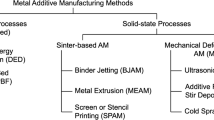Abstract
Recently, additive manufacturing (AM) has gained a lot of interest in industry and academia due to its capability of providing parts of unprecedented geometric complexity. A well-studied and, thus, the most commonly used material for processing via AM is Ti-6Al-4V with applications in the biomedical and aerospace sectors. However, for numerous envisaged applications, different materials, such as stainless steels or Ni-base alloys, have to be contemplated. As these alloys do not undergo a phase transformation upon cooling from solidification to room temperature, the microstructure induced by AM is completely different to that of Ti-6Al-4V. The current paper highlights the impact of different AM techniques, namely selective laser melting (SLM) and electron beam melting (EBM), on the microstructure evolution and concurrent implications for the resulting mechanical properties. Possibilities for direct microstructural design as well as necessities for post-process treatments are presented and discussed.
Zusammenfassung
Die Additive Fertigung (AM) gewinnt sowohl in der Industrie als auch in der Forschung mehr und mehr an Bedeutung aufgrund der Herstellbarkeit geometrisch hochgradig komplexer Teile. Ein weitgehend erforschtes und damit das am häufigsten additiv verarbeitete Material ist Ti-6Al-4V mit typischen Anwendungen in der Biomedizin und dem Luftfahrtbereich. Für weitere angedachte Anwendungen müssen andere Materialien, wie rostfreie Stähle oder Ni-Basis-Legierungen, qualifiziert werden. Diese durchlaufen jedoch keine Phasenumwandlung bei der Abkühlung von der Erstarrungs- auf Raumtemperatur, weshalb sich die durch den AM-Prozess induzierte Mikrostruktur erheblich von der der Ti-6Al-4V Legierung unterscheidet. Diese Arbeit stellt den Einfluss verschiedener AM-Prozesse, nämlich des selektiven Laserschmelzens (SLM) und des selektiven Elektronenstrahlschmelzens (EBM), auf die Mikrostrukturentwicklung und deren Bedeutung für die resultierenden mechanischen Eigenschaften vor. Die Möglichkeiten zur direkten Einstellung der Mikrostruktur als auch die Notwendigkeit nachgeschalteter (Wärme‑)Behandlungen werden vorgestellt und diskutiert.





Similar content being viewed by others
References
Riemer, A.; Leuders, S.; Thöne, M.; Richard, H. A.; Tröster, T.; Niendorf, T.: On the fatigue crack growth behavior in 316L stainless steel manufactured by selective laser melting, Engineering Fracture Mechanics, 120 (2014), pp 15–25
Thijs, L.; Kempen, K.; Kruth, J.-P.; van Humbeeck, J.: Fine-structured aluminium products with controllable texture by selective laser melting of pre-alloyed AlSi10Mg powder, Acta Materialia, 61 (2013), no. 5, pp 1809–1819
Niendorf, T.; Leuders, S.; Riemer, A.; Richard, H. A.; Tröster, T.; Schwarze, D.: Highly Anisotropic Steel Processed by Selective Laser Melting, Metallurgical and Materials Transactions B, 44 (2013), no. 4, pp 794–796
Niendorf, T.; Leuders, S.; Riemer, A.; Brenne, F.; Tröster, T.; Richard, H. A.; Schwarze, D.: Functionally Graded Alloys Obtained by Additive Manufacturing, Advanced Engineering Materials, 16 (2014), no. 7, pp 857–861
Pröbstle, M.; Neumeier, S.; Hopfenmüller, J.; Freund, L. P.; Niendorf, T.; Schwarze, D.; Göken, M.: Superior creep strength of a nickel-based superalloy produced by selective laser melting, Materials Science and Engineering A, 674 (2016), pp 299–307
Brenne, F.; Taube, A.; Pröbstle, M.; Neumeier, S.; Schwarze, D.; Schaper, M.; Niendorf, T.: Microstructural design of Ni-base alloys for high-temperature applications, Progress in Additive Manufacturing, 1 (2016), no. 3‑4, pp 141–151
Acknowledgements
The authors would like to thank Dr.-Ing. Andre Riemer and Alexander Taube (Direct Manufacturing Research Center (DMRC), Paderborn, Germany) as well as Dr. Dieter Schwarze (SLM Solutions AG, Lübeck, Germany) and Dr.-Ing. Steffen Neumeier (FAU Erlangen-Nürnberg, Germany) for fruitful discussions in the context of recent collaborative projects. Financial support by Deutsche Forschungsgemeinschaft under Contract No. NI1327/7-1 is gratefully acknowledged.
Author information
Authors and Affiliations
Corresponding author
Additional information
Results shown in the current study are derived from several collaborative research projects conducted in recent years. For details on process parameters and experimental procedures, the reader is referred to the respective publications.
Rights and permissions
About this article
Cite this article
Brenne, F., Leuders, S. & Niendorf, T. On the Impact of Additive Manufacturing on Microstructural and Mechanical Properties of Stainless Steel and Ni-base Alloys. Berg Huettenmaenn Monatsh 162, 199–202 (2017). https://doi.org/10.1007/s00501-017-0590-y
Received:
Accepted:
Published:
Issue Date:
DOI: https://doi.org/10.1007/s00501-017-0590-y




